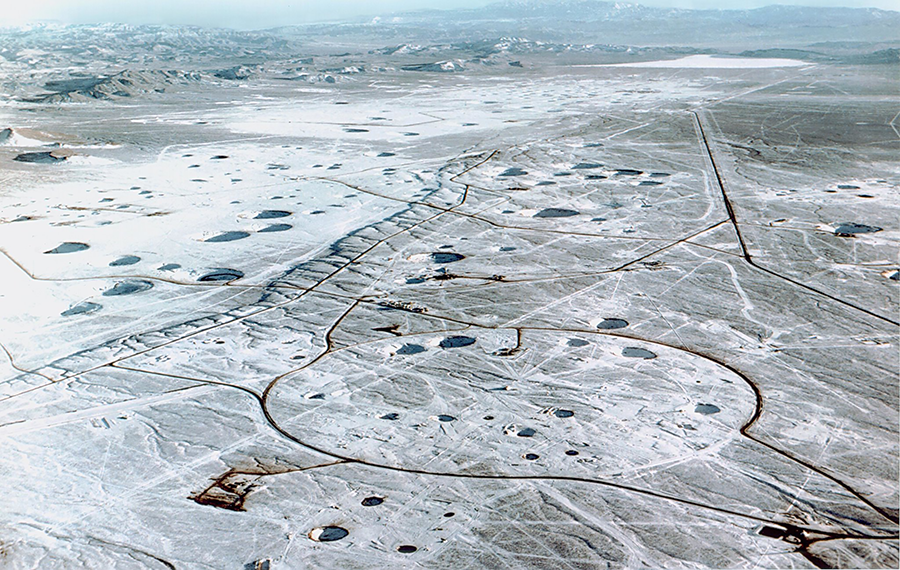Preserving the Nuclear Testing Taboo
September 2021
By Daryl G. Kimball
For the first five decades of the nuclear age, nuclear weapons test explosions were the most visible symbol of the dangers of nuclear weapons and the omnipresent threat of nuclear war. Most of the 2,000-plus nuclear test blasts were used to confirm new warhead designs and develop more deadly weapons systems, which in turn fueled a dangerous spiral of global nuclear competition.
 Nuclear testing also produced radioactive contamination, not only immediately downwind from the test sites but globally. One independent study from 1991 estimates that nuclear testing led to nearly half a million additional cancer fatalities worldwide through the year 2000.
Nuclear testing also produced radioactive contamination, not only immediately downwind from the test sites but globally. One independent study from 1991 estimates that nuclear testing led to nearly half a million additional cancer fatalities worldwide through the year 2000.
But since the conclusion of the Comprehensive Test Ban Treaty (CTBT), nuclear testing has become taboo. The treaty, which opened for signature on Sept. 24, 1996, has near-universal support with 185 signatories, including the five original nuclear testing states. All CTBT states agree that the treaty prohibits “any nuclear weapons test explosion, or any other nuclear explosion” no matter what the yield.
Even those nuclear-armed states that have not signed or not ratified the CTBT, including India, Israel, and Pakistan, observe nuclear testing moratoriums. Only one country has conducted nuclear test explosions in this century, and even that country—North Korea—halted nuclear testing
in 2017.
The CTBT has achieved its core goal: ending all nuclear testing. By this measure, the treaty is one of the most successful agreements in the long history of nuclear arms control and nonproliferation. Without the option to conduct nuclear tests, it is more difficult, although not impossible, for even the most advanced nuclear states to develop, prove, and field new warhead designs. The CTBT is a powerful brake on vertical and horizontal nuclear proliferation.
But we cannot take the nontesting norm for granted. It was only a year ago that some senior Trump officials suggested the United States should resume nuclear testing for the first time in 28 years to intimidate Russia and China. The treaty’s onerous entry-into-force requirement and the failure of eight holdout states, including the United States and China, to ratify the treaty has delayed its full implementation. As a result, the door to nuclear testing remains ajar.
Given the high stakes, there is no room for complacency from the U.S. and other governments, which should understand the importance of preventing the spread of ever more lethal nuclear weapons. States-parties to the nuclear Nonproliferation Treaty (NPT) should strengthen their call to action on the CTBT at the upcoming NPT review conference.
President Joe Biden, a long-time CTBT advocate, should reaffirm U.S. support for the treaty and its entry into force. As he declared in 2020, “We have not tested a [nuclear] device since 1992, we don’t need to do so now. A resumption of testing is more likely to prompt other countries to resume militarily significant nuclear testing and undermine our nuclear nonproliferation goals.”
As importantly, the Biden administration needs to pursue the adoption of additional voluntary measures designed to detect and deter possible low-level, clandestine nuclear testing by the major nuclear powers.
Today, the United States, China, and Russia—all CTBT signatories—continue to engage in weapons-related activities at their former nuclear testing sites. Only France has permanently closed its former test site. Although the treaty’s International Monitoring System is operational and far more effective than originally envisioned, very low-yield nuclear weapons test explosions can still be difficult to detect without on-site monitoring equipment or on-site inspections.
In May 2019, the director of the U.S. Defense Intelligence Agency charged that “Russia probably is not adhering to its nuclear testing moratorium in a manner consistent with the ‘zero-yield’ standard outlined in the [CTBT].” In April 2020, the State Department claimed that, “during the 1995–2018 timeframe, Russia probably conducted nuclear weapons-related tests” at Novaya Zemlya. In April 2021, the State Department repeated the claim without specifying when such activities may have occurred.
Russia, which has signed and ratified the CTBT, has vigorously denied the charge and pointed to the failure of the United States to ratify the treaty.
If the U.S. government takes its own intelligence reports and arms control compliance seriously, it should develop a proposal for mutual confidence-building measures, such as notification and exchange of information about certain experiments and the installation of additional sensory devices.
Russia suggests such measures should only be pursued after entry into force. That is an unhelpful position. If Russia truly supports entry into force of the CTBT, it could leverage progress by agreeing to implement these voluntary, reciprocal transparency measures after the United States ratifies the CTBT.
A quarter century after it was negotiated, the CTBT has brought an end to nuclear testing. But to keep a de facto global nuclear test moratorium intact, friends of the CTBT will need to do more to rejuvenate efforts to achieve its entry into force and reinforce the taboo against nuclear testing.
